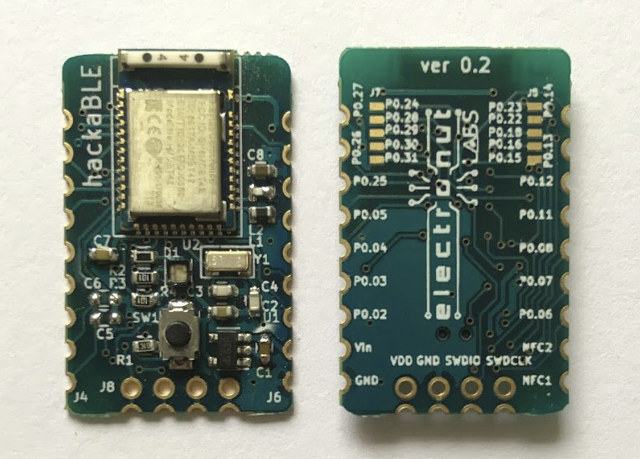Earlier this year, I wrote about Electronut Labs’ Bluey development board powered by Nordic Semi nRF52832 development board with BLE, NFC, and a few sensors, and partially open source hardware with the KiCAD schematics and PCB layout available on Github.
The company is now back with another open source hardware nRF52832 BLE board, namely hackaBLE, that’s much smaller (28x18mm), and with 2.54mm pitch castellated pin headers making suitable for use for breadboard, or as a module on a custom designed board.

hackaBLE board specifications:
- SoC – Nordic Semi nRF52832 ANT + BLE ARM Cortex-M4 @ 64 MHz processor with 512kB flash, 64kB RAM
- Connectivity – Bluetooth 4.2/5 LE and other proprietary 2.4 GHz wireless standards via chip antenna
- Expansion
- 2x 9-pin castellated headers with GPIO, 5V, 3.3V, and GND
- 2x 5-pin solder pads for more I/Os
- Debugging – 4-pin SWD header
- Misc – RGB LED, and user button
- Power Supply – 5 V via VDD or Vin pin.
The company explains “hackaBLE use offers more value than just using the BLE module directly – since it incorporates the necessary passive components – including the ones for the buck converter for power saving – and adds an RGB LED and a button for convenience. It’s also much easier to solder than the bare modules.”. More details, including the KiCAD schematics and PCB layout can be found on Github, as well as the PCB footprint for the board for those who plan on making a custom board.

The company can also provide PogoProg board with 4 pogo pins to program the board through the SWD header, Bumpy SWD debugger, and snapVCC board outputting 5V/3.3V from a 9V battery.
hackaBLE can be purchased from Tindie for $20, and you could also get the $44 premium devkit with hackaBLE and the three boards mentioned and pictured above.

Jean-Luc started CNX Software in 2010 as a part-time endeavor, before quitting his job as a software engineering manager, and starting to write daily news, and reviews full time later in 2011.
Support CNX Software! Donate via cryptocurrencies, become a Patron on Patreon, or purchase goods on Amazon or Aliexpress





